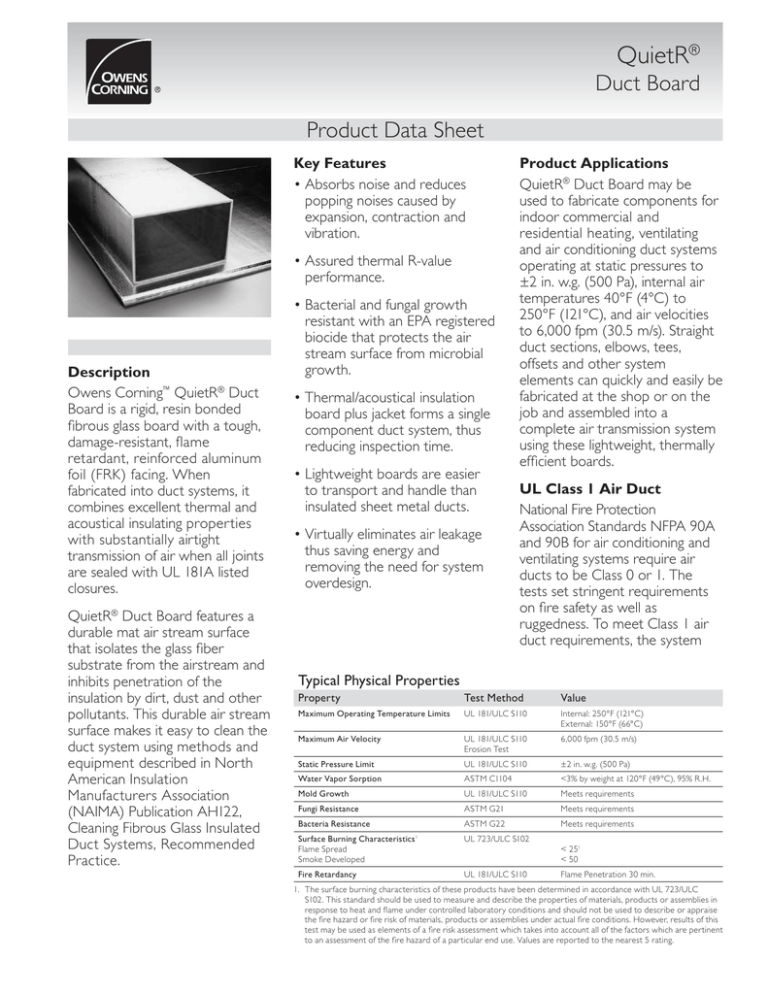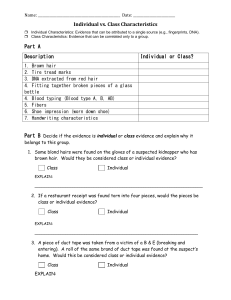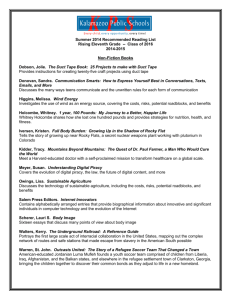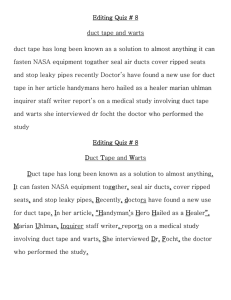57577-L QuietR Duct Board Product Data Sheet
advertisement

QuietR® Duct Board Product Data Sheet Key Features • Absorbs noise and reduces popping noises caused by expansion, contraction and vibration. • Assured thermal R-value performance. Description Owens Corning™ QuietR® Duct Board is a rigid, resin bonded fibrous glass board with a tough, damage-resistant, flame retardant, reinforced aluminum foil (FRK) facing. When fabricated into duct systems, it combines excellent thermal and acoustical insulating properties with substantially airtight transmission of air when all joints are sealed with UL 181A listed closures. QuietR® Duct Board features a durable mat air stream surface that isolates the glass fiber substrate from the airstream and inhibits penetration of the insulation by dirt, dust and other pollutants. This durable air stream surface makes it easy to clean the duct system using methods and equipment described in North American Insulation Manufacturers Association (NAIMA) Publication AH122, Cleaning Fibrous Glass Insulated Duct Systems, Recommended Practice. • Bacterial and fungal growth resistant with an EPA registered biocide that protects the air stream surface from microbial growth. • Thermal/acoustical insulation board plus jacket forms a single component duct system, thus reducing inspection time. • Lightweight boards are easier to transport and handle than insulated sheet metal ducts. • Virtually eliminates air leakage thus saving energy and removing the need for system overdesign. Product Applications QuietR® Duct Board may be used to fabricate components for indoor commercial and residential heating, ventilating and air conditioning duct systems operating at static pressures to ±2 in. w.g. (500 Pa), internal air temperatures 40°F (4°C) to 250°F (121°C), and air velocities to 6,000 fpm (30.5 m/s). Straight duct sections, elbows, tees, offsets and other system elements can quickly and easily be fabricated at the shop or on the job and assembled into a complete air transmission system using these lightweight, thermally efficient boards. UL Class 1 Air Duct National Fire Protection Association Standards NFPA 90A and 90B for air conditioning and ventilating systems require air ducts to be Class 0 or 1. The tests set stringent requirements on fire safety as well as ruggedness. To meet Class 1 air duct requirements, the system Typical Physical Properties Property Test Method Value Maximum Operating Temperature Limits UL 181/ULC S110 Internal: 250°F (121°C) External: 150°F (66°C) Maximum Air Velocity UL 181/ULC S110 Erosion Test 6,000 fpm (30.5 m/s) Static Pressure Limit UL 181/ULC S110 ±2 in. w.g. (500 Pa) Water Vapor Sorption ASTM C1104 <3% by weight at 120°F (49°C), 95% R.H. Mold Growth UL 181/ULC S110 Meets requirements Fungi Resistance ASTM G21 Meets requirements Bacteria Resistance ASTM G22 Meets requirements Surface Burning Characteristics1 Flame Spread Smoke Developed UL 723/ULC S102 Fire Retardancy UL 181/ULC S110 < 251 < 50 Flame Penetration 30 min. 1. The surface burning characteristics of these products have been determined in accordance with UL 723/ULC S102. This standard should be used to measure and describe the properties of materials, products or assemblies in response to heat and flame under controlled laboratory conditions and should not be used to describe or appraise the fire hazard or fire risk of materials, products or assemblies under actual fire conditions. However, results of this test may be used as elements of a fire risk assessment which takes into account all of the factors which are pertinent to an assessment of the fire hazard of a particular end use. Values are reported to the nearest 5 rating. QuietR® Duct Board Product Data Sheet must withstand UL 181/ULC S110 tests such as errosion, pressure loss, impact, collapse, puncture, static load and fire retardancy (30 minute flame penetration test). Also, to qualify as a Class 1 Air Duct System, the following UL 723/ULC S102 fire testing requirements must be met: Flame spread, 25; Smoke developed, 50. Limitations Fiber glass ducts should not be used in the following applications: A. Kitchen or fume exhaust ducts, or to convey solids or corrosive gases; B. In concrete or buried below grade; C. Outdoors; D. As casings and/or housings of built-up equipment; E. Immediately adjacent to high temperature electric heating coils without radiation protection; F. For vertical risers in air duct systems serving more than two stories in height; G. With coal or wood fueled equipment, or with equipment of any type which does not include automatic maximum temperature controls; NAIMA (North American Insulation Manufacturers Association) Fibrous Glass Duct Construction Standards or SMACNA (Sheet Metal and Air Conditioning Contractors National Association) Fibrous Glass Duct Construction Standards. One of the following closure methods must be employed to meet the requirements of UL 181/ULC S110. USE OF A NON-LISTED CLOSURE SYSTEM VOIDS THE UL CLASS 1 AIR DUCT RATING. sheet metal sleeve extending through the fire wall; or J. When the duct system is located in non-conditioned space and is used for cooling only (when heating is from another source), unless all registers which would allow moist air into the duct system are vapor sealed during the heating season to prevent condensation from forming inside the duct. Technical Information Fabrication and installation of fiber glass Duct Systems shall be in accordance with the UL listing and shall conform to Owens Corning’s published methods and/or latest editions of 1. Pressure-Sensitive Tape Any tape listed and labeled under UL 181A, Part I (P). a. All longitudinal and Thermal Performance 1" (25mm) 1½" (38mm) R-value, hr•ft 2•°F/Btu (RSI, m2•°C/W) 4.30 (0.76) 6.50 (1.15) 2" (51mm) 8.70 (1.53) k-value, Btu•in/hr•ft 2•°F (W/m•°C) 0.23 (0.033) 0.23 (0.033) 0.23 (0.033) C-value, Btu/hr•ft 2•°F (W/m2•°C) 0.23 (1.32) 0.16 (0.87) 0.12 (0.65) Mean temperature is the average of two temperatures: that of the air inside the duct and that of the ambient air outside it. Note: Specified design thickness should be adequate to prevent exterior surface condensation. Acoustical Performance Sound absorption coefficients at octave band center frequencies, Hz. 125 250 500 1000 2000 4000 Type 475, 1" (25mm) Type 0.08 0.19 0.69 0.94 0.99 0.98 NRC 0.70 Type 800, 1½" (38mm) 0.12 0.33 0.92 1.04 1.03 1.02 0.85 Type 1400, 2" (51mm) 0.14 0.72 1.15 1.12 1.06 1.07 1.00 These data were collected using a limited sample size and are not absolute values. Therefore, reasonable tolerances must be applied. Tests were conducted in accordance with ASTM C423, Mounting A (material placed against a solid backing). H. In variable air volume systems on the high pressure side unless reinforced to withstand the full fan pressure; Product Availability I. As penetrations in construction where fire dampers are required, unless the fire damper is installed in a QuietR® Fiber Glass Duct Board is available in the following forms: Density, pcf (kg/m3) Type Thickness Type 475 1" (25mm) 4.4 (70) Type 800 1½" (38mm) 3.8 (61) Type 1400 2" (51mm) 3.8 (61) Type designates board stiffness defined by flexural rigidity. Type selection depends on duct size, pressure and reinforcement schedule. The 1½" (38mm) and 2" (51mm) thickness provides superior thermal value. QuietR® Duct Board Product Data Sheet circumferential joints must be stapled with outward flaring ½" (13mm) (min.) staples, 2" (50mm) (approx.) O.C. b. Wipe surface where tape is to be applied to field joints with clean cloth. If surface has grease or oil, saturate cloth with approved solvent. Refer to tape manufacturer’s recommendations. c. Center tape over edge of stapling flap and rub firmly in place immediately after application, using a squeegee or similar tool. d. A heat sealing iron must be used to assure a good bond when installed below 50°F (10°C). e. Tape should not be applied to surface of duct board when temperature is below 32°F (0°C) due to the possibility of entrapping ice crystals which will cause tape to loosen upon melting. Heat surface first to drive off moisture. 2. Heat-Activated Tape Any tape listed and labeled under UL 181A,Part II (H). a. All longitudinal and circumferential joints must be stapled with outward flaring ½" (13mm) (min.) staples, 2" (50mm) (approx.) O.C. b. Wipe surface where tape is to be applied with clean cloth. If surface has grease or oil, saturate cloth with approved solvent. Refer to tape manufacturer’s recommendations. c. Center tape over joint and seal down tape end with 500°F (260°C) iron. Do not use heat gun; heat and pressure are both required to effect a seal. d. Press down entire length of tape to hold in place using a smearing action to get good bond. Colored dots on tape surface darken when satisfactory bonding temperature is reached. e. Staples may be omitted when automatic closure machines such as Glass Master Closemasters are used. Iron temperature must be set at 650°F (343°C) minimum. Continuous production may require periodic pauses to allow sealing iron to recover to 650°F (343°C). f. Allow joint to cool before stressing. 3. Mastic and Glass Fabric Any mastic and glass fabric closure system listed and labeled under UL 181, Part III (M). a. All longitudinal and circumferential joints must be stapled with outward flaring ½" (13mm) (min.) staples, 2" (50mm) (approx.) O.C. b. Brush mastic onto joint and embed glass fabric in mastic. c. Brush second coat of mastic over fabric until completely filled. d. Allow joints to dry in accordance with mastic manufacturer’s recommendation before pressurizing system. Tips to Avoid Mold Growth in Ducts • Mold in duct systems occurs when moisture comes into contact with dirt or dust collected on the duct system surfaces. Proper filters will minimize the collection of dust and dirt, but care needs to be exercised to prevent water formation in the duct. A properly sized and operated air conditioning unit will minimize the likelihood of water formation. • The system must be maintained and operated to insure that sufficient dehumidification is occurring and that filters are installed and changed as recommended by the equipment manufacturer. Standards, Code Compliance • Meets NFPA 90A/90B • Meets ICC International Mechanical Code, Corps of Engineers Guide Spec., NYC MEA #186-69 • Supported by NAIMA and SMACNA industry standards • Meets requirements of ASTM C1338, ASTM G21 (fungi test) and ASTM G22 (bacteria test) QuietR® Duct Board Product Data Sheet Certifications and Sustainable Features of QuietR® Duct Board • Certified by Scientific Certification Systems to contain a minimum of 57% recycled glass content • Certified to meet indoor air quality standards under the stringent GREENGUARD Indoor Air Quality Certification Program, and the GREENGUARD Gold Certification.* Environmental and Sustainability Owens Corning is a worldwide leader in building material systems, insulation and composite solutions, delivering a broad range of highquality products and services. Owens Corning is committed to driving sustainability by delivering solutions, transforming markets and enhancing lives. More information can be found at http:// sustainability.owenscorning.com. * Duct Board up to and including 1" is GREENGUARD Gold Certified. Disclaimer of Liability Technical information contained herein is furnished without charge or obligation and is given and accepted at recipient’s sole risk. Because conditions of use may vary and are beyond our control, Owens Corning makes no representation about, and is not responsible or liable for the accuracy or reliability of data associated with particular uses of any product described herein. Nothing contained in this bulletin shall be considered a recommendation. GREENGUARD Certified products are certified to GREENGUARD standards for low chemical emissions into indoor air during product usage. For more information, visit ul.com/gg. OWENS CORNING INSULATING SYSTEMS, LLC ONE OWENS CORNING PARKWAY TOLEDO, OHIO 43659 1-800-GET-PINK® www.owenscorningcommercial.com Pub. No. 57577-L. Printed in U.S.A. July 2014. THE PINK PANTHER™ & ©1964-2014 Metro-Goldwyn-Mayer Studios Inc. All Rights Reserved. The color PINK is a registered trademark of Owens Corning. © 2014 Owens Corning. All Rights Reserved.



